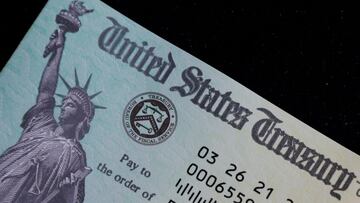How many stimulus checks have been there until now and when were they paid?
The American Rescue Plan Act will provide 160 million Americans with a stimulus check of up to $1,400. We look at the three rounds of aid since the pandemic started.

On March 11 2020, the World Health Organization officially declared the Coronavirus situation a pandemic. Just over a year on and the United States remains the worst hit with the total number of reported cases at 30,332,358 and 550,073 deaths related to the virus, according to today’s figures. The Covid-19 pandemic also caused sweeping job losses, with unemployment hitting a high of 14.8% during April 2020 – the worst month of the crisis. Unemployment figures have since recovered and currently stand at 6.2% as of March 2021. That prompted lawmakers to draw up the first Covid-19 Relief Bill to bring economic aid to Americans either struggling to make ends meet or who had lost income because of the pandemic.
Third stimulus check missing: why it could be taking longer and when to expect it
New proposals would slash gift tax entitlement
Third stimulus check missing: when was it passed and sent out?
First Covid-19 relief bill signed off by Trump in March 2020
The CARES Act was signed into law by previous president Donald Trump on Friday 27 March 2020. The CARES Act provided a first round of stimulus payments valued at $1,200 for each individual who complied to a set of conditions, with $500 for each eligible dependent under 16 years of age, with a maximum of three dependents per household.
The payments were made to everyone earning under the income threshold, which were set at Adjusted Gross Income of $75,000 ($150,000 for married couples filing jointly) with the stimulus check value reducing by $5 for every $100 in income up to a maximum of $99,000 ($198,000 for married couples filing jointly). The very first stimulus checks were paid into people's bank accounts over the weekend of the 11 and 12 of April, either via direct deposit into individuals’ bank accounts, paper checks sent through the post; approximately 4 million payments were issued on a prepaid debit card, the Economic Impact Payment (EIP) Card which were sent out in late May last year.
✓ Passed the Senate
— Senate Republicans (@SenateGOP) March 27, 2020
✓ Passed the House
Next stop → @realdonaldtrump's desk
Help is on the way. pic.twitter.com/oCGRMwh2Ia
Proposals for a second bill
By July, talks had already started for a second round of stimulus aid; the CARES 2 package was reviewed by the administration and an agreement in principle was reached on the basic points outlined in the package but it never made it to the Senate or passed. Nor was the mooted HEROES Act, a $3 trillion economic stimulus bill which was passed by the House by a vote of 208–199 on 15 May 2020 with further negotiations and modifications dragged out over the next few month before dying a death before it reached a Senate vote.
Since we passed the American Rescue Plan, we’re starting to see new signs of hope in our economy. pic.twitter.com/EZys2d0aG7
— President Biden (@POTUS) March 26, 2021
Trump passes second round of Covid economic aid in December 2020
The second round of stimulus aid, a $900 billion package which was part of the Coronavirus Response and Relief Supplemental Appropriations Act of 2021 was signed off by Trump on Sunday 27 December 2020. It provided a one-off payment of up to $600, with households also able to claim an additional $600 for child dependents aged 16 or under. Those who earned under $75,000 in the 2019 tax year received the full stimulus check, while a steadily smaller figure was given to those on a higher annual income, up to a maximum phase-out limit of $87,000. The first payments, through direct deposit and paper checks with some later payments made by EIP 2 Cards, were issued between 29 December 2020 and 15 January 2021.
Those who didn’t receive a stimulus payment either through the CARES Act or the December Covid-19 Relief bill can still claim for it retroactively when filing their federal tax returns for 2020 through the Recovery Rebate Credit. This year, the tax deadline for individuals to file and pay most federal income taxes has been extended to Monday 17 May 2021. Claimants will also be able to claim any additional money owed by the IRS from the first round of payments sent out earlier in 2020 as a credit.
63 percent of our workers are living paycheck to paycheck during this pandemic.
— Bernie Sanders (@SenSanders) March 19, 2021
Meanwhile, 664 billionaires got $1.3 trillion richer.
Maybe – just maybe – it’s time to build an economy that works for all. pic.twitter.com/fYr5V1XPLC
The third round of Covid-19 relief: Biden signs off the American Rescue Plan in March 2021
The third, most recent round of Covid-19 stimulus came as part of the $1.9tn American Rescue Plan Act which was passed by the House of Representatives on 26 February by a vote of 219–212 then just made it through the Senate with a 51-50 vote. It was approved on 10 March and passed over for recently-elected President Joe Biden to sign it off on 11 March. It promised stimulus checks of up to $1,400 for each eligible American. There were some changes - eligibility requirements tightened to exclude individuals earning over $80,000 or couples with a combined income of more than $160,000. Another eligibility change saw adult dependents able to get a stimulus check for the first time, meaning that millions of college students, elderly relatives and disabled Americans will be getting a payment.
Related stories
The first stimulus payments were issued by direct deposit and hit individuals’ back accounts on Saturday 12 March. Since the first batch of 90 million payments, the IRS and Treasury dispatched a second batch to around 37 million taxpayers on 24 March.
What are the chances of a fourth stimulus check?
Plans for a fourth stimulus check are gaining support from Congress. A number of Democrats continue to push for a fourth check which would include recurring payments until the pandemic has waned. Newsweek report that 64 lawmakers are urging for a fourth stimulus check with recurring checks to follow. Earlier this month, 11 Senators, including Bernie Sanders and Elizabeth Warren, called for Joe Biden to extend unemployment compensation indefinitely on top of another round of checks.

